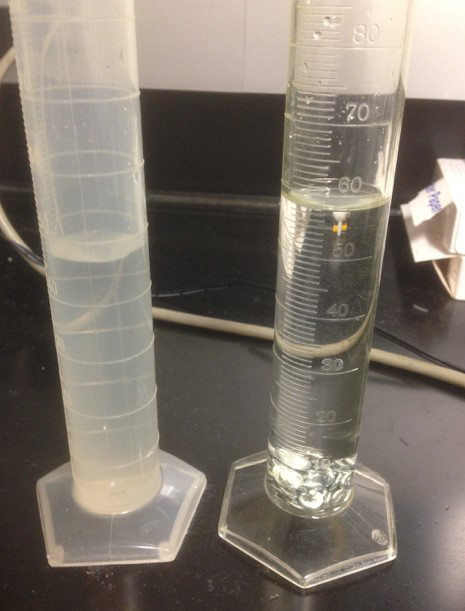Determining the Density of a Solid and Liquid
Overview
Source: Laboratory of Dr. Michael Evans — Georgia Institute of Technology
The ratio of the mass of a substance to its volume is known as the mass density or, simply, the density of the substance. Density is expressed in units of mass per volume, such as g/mL or kg/m3. Because the density of a substance does not depend on the amount of substance present, density is an “intensive property”.
To measure the density of a sample of material, both the mass and volume of the sample must be determined. For both solids and liquids, a balance can be used to measure mass; however, methods for determining volume are different for solids and liquids. As liquids can flow and take the shapes of their containers, glassware such as a graduated cylinder or volumetric flask can be used to measure the volume of a liquid. The volume of an irregularly-shaped solid can be measured by submersion in a liquid — the difference in volume caused by addition of the solid is equal to the volume of the solid.
This demonstration illustrates the methods for measuring the density of solids and liquids. Using a volumetric flask and an analytical balance, the density of ethanol can be determined. Using a graduated cylinder, analytical balance, and water as the displaced liquid, the density of zinc metal can be determined.
Procedure
1. Determination of the Density of Liquid Ethanol
- Place a clean and dry 50-mL volumetric flask on an analytical balance.
- Press the “Tare” or “Zero” button on the balance. The balance should read 0.000 g.
- Use a buret funnel to add 45 mL of liquid ethanol to the volumetric flask.
- Use a Pasteur pipette to add the final 5 mL of liquid, just until the bottom of the liquid’s meniscus touches the marking on the flask.
- Weigh the volumetric flask ag
Results
Table 1 lists results for the determination of the density of ethanol using a 50-mL volumetric flask. Densities were calculated by dividing the measured mass by 50.0 mL. The mean measured density was 0.789 ± 0.001 g/mL. Table 2 lists results for the determination of the density of a sample of zinc metal using a 100-mL graduated cylinder and the liquid displacement method. Note that the measured densities are constant (within experimental error) for both substances. Table 2
Application and Summary
Density is a characteristic intensive property of a substance. Thus, density measurements can be used to identify an unknown pure substance if a list of possible reference densities is available. For example, density can be used to distinguish between metals similar in outward appearance (Figure 2).
In contexts where very low or very high mass is desirable, density is a critical material property. Materials engineers carefully consider the density of materials for construction
Skip to...
Videos from this collection:

Now Playing
Determining the Density of a Solid and Liquid
General Chemistry
556.9K Views

Common Lab Glassware and Uses
General Chemistry
659.0K Views

Solutions and Concentrations
General Chemistry
275.4K Views

Determining the Mass Percent Composition in an Aqueous Solution
General Chemistry
383.8K Views

Determining the Empirical Formula
General Chemistry
183.8K Views

Determining the Solubility Rules of Ionic Compounds
General Chemistry
141.6K Views

Using a pH Meter
General Chemistry
346.9K Views

Introduction to Titration
General Chemistry
425.7K Views

Ideal Gas Law
General Chemistry
79.4K Views

Spectrophotometric Determination of an Equilibrium Constant
General Chemistry
158.8K Views

Le Châtelier's Principle
General Chemistry
265.8K Views

Freezing-Point Depression to Determine an Unknown Compound
General Chemistry
160.8K Views

Determining Rate Laws and the Order of Reaction
General Chemistry
196.4K Views

Using Differential Scanning Calorimetry to Measure Changes in Enthalpy
General Chemistry
44.8K Views

Coordination Chemistry Complexes
General Chemistry
91.8K Views
Copyright © 2025 MyJoVE Corporation. All rights reserved
